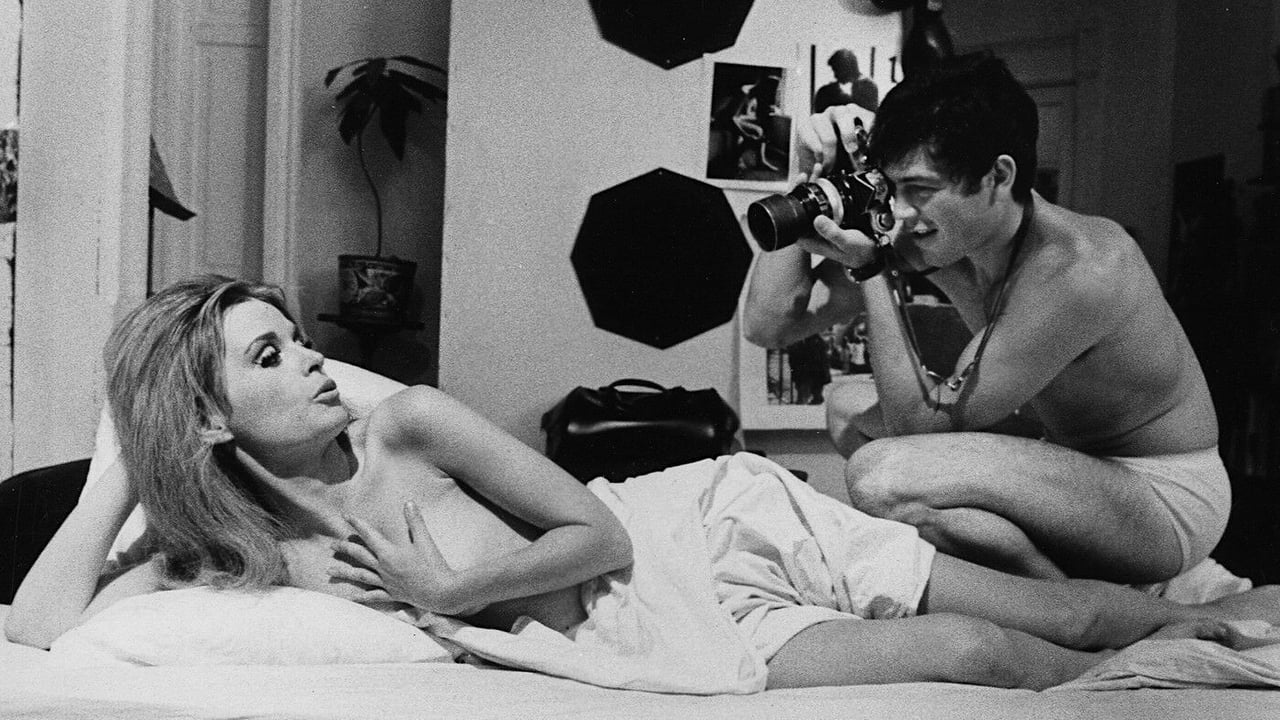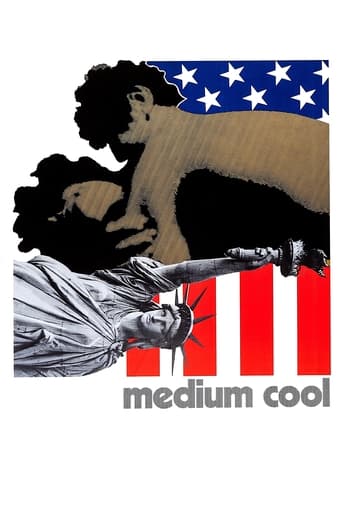

John Cassellis (Robert Forster) is a TV reporter. This follow his work and personal life. It's a scatter shot of his life and Eileen (Verna Bloom) and her son. It's a semi-documentary where the lines of fiction and reality are often blurred. Sometimes, the only way to tell is the presence of a recognizable actor like Peter Boyle.The film could be very disjointed and experimental. It's diving into the counter culture head first. None of the black activists are willing to discuss anything other than that they don't trust him to do an interview. There is a roller derby match, and a psychedelic Mothers of Invention concert. It is one big jumble.Then it get surreal with Verna Bloom in her bright yellow dress walking among the protesters of the 68 Democratic convention. The riot police are out in full force, and so is the army. I would suggest anybody who find themselves drifting to stay with it to see final section. It is utterly fascinating.
... View MoreMEDIUM COOL is one of the most terrifying films ever made.The photography is beautiful, set up by the man who would one day be responsible for the inimitable DAYS OF HEAVEN. The result is visceral. It seems so incredibly "real."But MEDIUM COOL occupies this bizarre, hollow land on the spectrum of cinematic "realism." Realism is an abstraction. Never attainable and, at least in cinema, never wanted. By nature, movies present a clearly fictionalized atmosphere where events, people, and influences from reality are inserted. MEDIUM COOL inverts that system by inserting fictional characters into situations constructed from genuine human anger and fear. As far as cinematic innovation goes, this may be the most dangerous.Wexler is fabricating reality. Our culture is so full of corporations, politicians, and interests trying to construct their own portrait of reality. The movies might be the most famous example of this abstraction. However, MEDIUM COOL's danger exists in its presentation. Wexler was a genius. How he thought he could get away with this film I will never know. He inserts Eileen into the climactic riot, helplessly walking against the tide of police officers, clueless about the issues and only concerned with finding her son. His confidence in such direction points to the horrifying fact that he also believes that history is a malleable material. By inserting a fabrication, a symbol, into tangible human danger, Wexler argues for his ability to alter history. That delusion wouldn't be so dangerous if the material were not presented as a veritable document of late-1960's violence and ethics. The counterargument asserting that all cinema is presented such only strengthens this point -- if all films possess the trappings of realism, MEDIUM COOL attempts to create one anew. Ultimately, the moral argument is murky and Wexler's left-wing fortitude is made silly by the bookending car-wreck. The film turns out to be a self-indulgent autobiography on Wexler, himself. He doesn't try to hide his Godardian influence, but it becomes trite and facile with the final hijacking of LE MEPRIS. His obsession with the power of the camera eventually usurps fringe cultural concerns like Racism, Violence, Political Upheaval, and Feminism. They're all there in MEDIUM COOL, but in the end they only exist because of the camera.Much scholarship is made about Cassellis' responsibility as the hero. So many admire his calm inversion of stereotype. He is the archetypal revolutionary hero. Unmoved and unshaken in the face of tragedy (the opening, for example), he is depicted as someone who lives for the camera. As footage of MLK is shown (who was shot that year), he says "Jesus, I love shooting film." Cassellis is Wexler -- a grounded permutation of "heroic" behavior. But with plenty of faults to balance everything out.Maybe the most interesting question is -- why Wexler? why 1968? why distort filmic tradition now? The answer might be revealed when Wexler films a series of Black adults in the ghetto. They make (somewhat garbled) pleas for Cassellis to get in touch with the "real people." What was the late-60's revolution but a demand for individual attention and the premature glorification of youth? In MEDIUM COOL, Wexler makes an impossible attempt to faithfully represent the little man. This brings us back to the terrifying message of the film.All of this is not to say that MEDIUM COOL doesn't have brilliant sequences. If Wexler wandered around with a camera for a year, I would be fixated. The opening scenes at the security base, the final riot prelude (whenever Eileen was absent), and most scenes with Harold are perfect instructions for cinematic suggestions of reality. The pictures are colorful, focused, and energetic and most of the acting is realized successfully. Indeed, as long as the audience has the capacity to understand the fabrication they are seeing, the photography does enough to resurrect the broken ideology into a formal revolution in itself.MEDIUM COOL is a unique study in cinematic representation. Many passages render and preserve a critical cultural paradigm. One only wishes that Wexler might have actually filmed the events without feeling the need to dress them up.53.7
... View More"Medium Cool" (1968) Dir: Haskell WexlerWhen I first saw "Medium Cool" I was far too young to appreciate it for what it actually is. I loved it anyway, perhaps partially because it baffled me. I was born in suburban England in 1986, and thus had no frame of reference for the setting of social unrest that is used as an omnipresent main character, alongside Robert Forster's brilliant John Cassellis - news cameraman, modern professional, and casual womaniser. Critics of this film have said that the plot is too thin and unlikely to support its pretensions, and that the final scenes are merely opportunistic instead of profound. I disagree with this, but not directly - it does have pretensions, and it is a little thin on plot. But the final scenes are literally stunning, and have deservedly assured this film's place in history.Cassellis is clinical about his job and cynical towards his employers. In his own words, he loves to shoot film. He documents occurrences without judging them. In a way, he is like Gene Hackman's Harry Caul character in the equally brilliant "The Conversation", who doesn't care what people are talking about as long as he gets "a nice fat recording". But Cassellis is not an obsessive. Throughout the course of the film, he grows to accept the cultural and philosophical impact of his profession as a kind of vessel for public information. When he discovers his tapes are being viewed by the authorities, his principles are violated. We are shown the mutually antagonising relationship between 'the people' and 'the news media' as John realises the implications of what he has been contributing to. This sounds less than exciting, but the backdrop itself is Chicago circa 1968 - a city so restless and colourful that this fairly heavy concept is counterbalanced by the images themselves. We watch Cassellis and his soundman cover the National Guards' riot training, the morale-raising songs of a civil rights protest group, campaigners for Robert Kennedy, and more. A particularly memorable sequence involves the black residents of a tenement block explaining to the cameraman how he, as a representative of 'the media', carries the baggage of institutionalised prejudice through their front door. Sure, the tenants are actors (as is Peter Boyle as the Gun Clinic Manager) but they fit seamlessly. In this scene, as in most of the movie, the "cameraman" being spoken to is both the character of Cassellis, Haskell Wexler himself, and by extension everyone who is watching.How Harold and his mother Eileen relate to all of this is a more abstract and difficult question - they are natives of West Virginia, and the flashback scenes of deep country woodlands and old-fashioned religion seem to suggest that they represent the past, the "age of innocence" in the movie's tag-line. But this isn't the effect they have on the plot. They are out of place in this volatile city, but so is everyone else, John included. And when we are plunged into the heart of the riots for the last scenes of the film, we have no time to speculate on what exactly Wexler was trying to say; because he himself is there - the director is holding the camera, dodging tear gas and avoiding the batons of the riot police, and filming the injured protesters. Its significance is elevated beyond mere entertainment. The fiction in "Medium Cool" exists mainly to highlight the intimidating labyrinth of fact.There is technical boldness to be admired too: the cinematography is an impressive framing of undiluted reality, and the editing and soundtrack is inspired. The performances of Forster and the young amateur Harold Blankenship are equally captivating, with Verna Bloom not far behind.
... View MoreThis experimental late 60's effort is a great time-capsule movie. It captures feelings of unease and paranoia that are synonymous with the time. This was at a time where events such as Altamont and the Manson murders helped kill the hippy dream. Medium Cool depicts a cynicism that is very much in line with times.Set in Chicago during the '68 Democrat National Convention, the film follows a dispassionate news cameraman and his relationship with a country woman and her son. The story is slight. And the message is not entirely clear. But, apart from the time-capsule factor, what makes this movie worthwhile is the way in which it has been captured on film. The cinematography excellent in places. The opening credit sequence where the camera follows a dispatch bike rider through the streets of Chicago to the psychedelic main theme tune by Frank Zappa's Mothers of Invention is particularly well done. Similarly, the later shots of Verna Bloom walking through the anti-Vietnam riots clad in a little yellow summer dress is incredibly striking. Director Haskell Wexler was primarily a cinematographer so it is unsurprising that the look of the film is so important. On top of this, the idea of filming the actors in the settings of actual events, such as the riots and the Convention, gives the film a timeless quality and uniqueness that serves it well.On the negative side, some scenes do go on too long and 'the message' aspect can get slightly tiresome at times. The acting is good but characters are maybe a little too detached at times, making it hard for us to care too much for them. That said, however, the ending still packs an emotional punch.Other things to check out: An extended nude scene that must've been pretty shocking at the time. The psychedelic soundtrack is no too bad either including a groovy rock concert scene. Lastly, a black radical who talks in fluent jive 'you cat', 'you dig', etc very funny.If you're looking for a film with a great narrative then give Medium Cool a miss. If you would like to see a late 60's psychedelic/political mood piece with some great visuals and music, then give it a go.
... View More